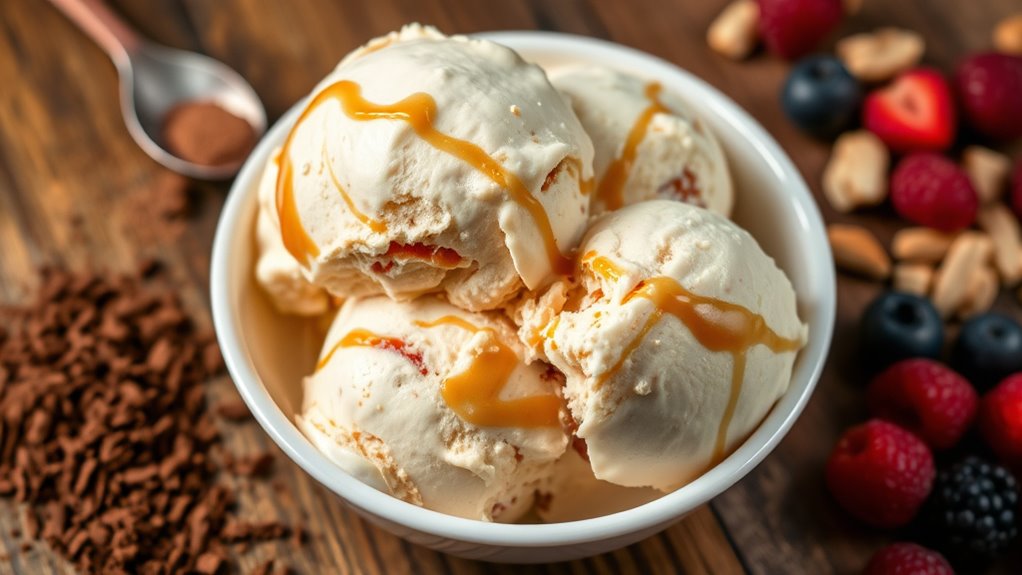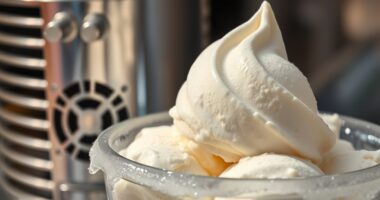Store-bought ice cream can’t match the endless customization, fresh ingredients, and diverse flavors you can create at home. Making ice cream yourself gives you control over quality, dietary needs, and texture, resulting in a richer, more satisfying treat. Plus, it’s cost-effective and better for the environment with less waste. If you’re curious about how homemade ice cream can transform your dessert game, you’ll find plenty of tips and ideas to get started.
Key Takeaways
- Homemade ice cream offers unlimited flavor customization and dietary flexibility, surpassing store-bought options.
- You control ingredient quality and avoid artificial additives, ensuring fresher, healthier treats.
- DIY ice cream achieves superior texture, creaminess, and freshness through personalized churning and storage methods.
- Making ice cream at home reduces packaging waste, lowers costs over time, and supports sustainable living.
- Creative experimentation with flavors and dietary needs makes homemade ice cream a personalized, satisfying experience.
Customization and Flavor Variety
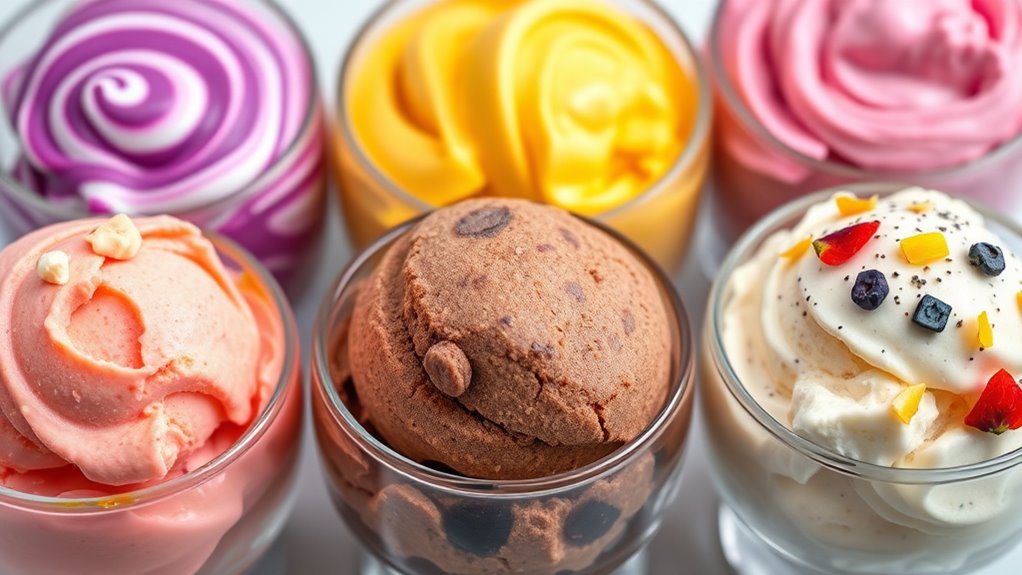
Homemade ice cream offers endless opportunities for customization and flavor variety. You can experiment with flavors that aren’t available in stores or combine ingredients to suit your taste. Want a rich chocolate base with hints of coffee or a fruity sorbet with exotic herbs? You can make it happen. Plus, homemade allows you to contemplate dietary needs—gluten-free, dairy-free, or low-sugar options—without sacrificing flavor. This flexibility means you’re not limited by commercial offerings and can create unique recipes tailored to your preferences. Whether you prefer classic vanilla, adventurous spice blends, or health-conscious ingredients, homemade ice cream gives you full control. The result is a personalized treat that reflects your taste and dietary considerations, making each batch truly one-of-a-kind. Additionally, with proper storage techniques, you can enjoy your creations at their best for longer periods.
Quality and Ingredient Control

When you make ice cream at home, you control the quality of every ingredient. Using fresh, natural components means your dessert tastes better and is healthier. Plus, you can create unique flavor combinations without worrying about unwanted additives. Incorporating essential oils in small, safe amounts can add an extra layer of flavor and aroma to your homemade ice cream.
Fresh, Natural Ingredients
Using fresh, natural ingredients is key to making high-quality ice cream. When you control your ingredients, you get better flavor and texture. You can choose dairy sourcing carefully, ensuring your milk and cream are fresh and free from additives. This allows for richer, more authentic taste. Plus, you can experiment with flavors confidently, knowing exactly what’s in your ice cream. Here’s a quick look at how ingredient quality impacts your creation:
| Ingredient Type | Benefit | Example |
|---|---|---|
| Dairy Sourcing | Freshness and purity | Local farm milk |
| Sweeteners | Better flavor, fewer additives | Honey or pure cane sugar |
| Enhancers | Natural, no artificial additives | Fresh fruit or vanilla beans |
Focusing on natural ingredients keeps your ice cream pure, delicious, and customizable. Ingredient quality plays a crucial role in achieving the best possible flavor and texture in your homemade ice cream.
No Unwanted Additives
Ensuring your ice cream contains no unwanted additives starts with careful ingredient selection. When you make it at home, you control what goes in, avoiding artificial sweeteners and preservatives often found in store-bought options. Many commercial brands add these to extend shelf life or cut costs, but they can compromise flavor and health. By choosing natural ingredients, you eliminate these unnecessary chemicals, ensuring a cleaner, healthier treat. Using fresh milk, real fruit, and natural sweeteners allows you to craft ice cream that’s free from synthetic additives. This not only improves taste but also provides peace of mind, knowing exactly what you’re consuming. With homemade ice cream, you enjoy a pure, wholesome dessert without unwanted additives lurking in the ingredients.
Custom Flavor Combinations
Creating custom flavor combinations for your homemade ice cream allows you to prioritize quality and ingredient control. You can choose fresh, natural ingredients and avoid artificial additives often found in store-bought options. This flexibility is especially helpful if you have dietary restrictions, as you can select dairy alternatives like coconut, almond, or oat milk to suit your needs. Experimenting with flavors—like adding fresh fruit, nuts, or spices—lets you craft unique blends tailored to your taste. By making ice cream at home, you guarantee each ingredient meets your standards, resulting in a healthier, more satisfying treat. Additionally, baking techniques can influence the texture and consistency of your ice cream, ensuring it turns out just right. Plus, you avoid unwanted preservatives and excess sugar, giving you full control over your dessert’s nutritional profile. Homemade ice cream truly puts you in charge of quality and flavor.
Cost-Effectiveness Over Time

Over time, making homemade ice cream can become more cost-effective compared to frequently buying it from stores. While the initial investment in equipment and ingredients might seem higher, the ongoing cost savings quickly add up. You pay once for items like a good ice cream maker, and then enjoy low-cost ingredients such as milk, sugar, and flavorings. This makes it a smart long-term investment, especially if you crave ice cream regularly. Over multiple batches, your per-serving cost drops markedly, saving you money in the long run. Plus, you control the ingredients, avoiding additives and preservatives. Additionally, choosing the right headphones for your needs can enhance your overall experience, whether you’re listening to music or watching movies. In the end, homemade ice cream not only delivers better quality but also proves to be a budget-friendly choice that pays off over time.
Healthier Alternative to Store-Bought Options
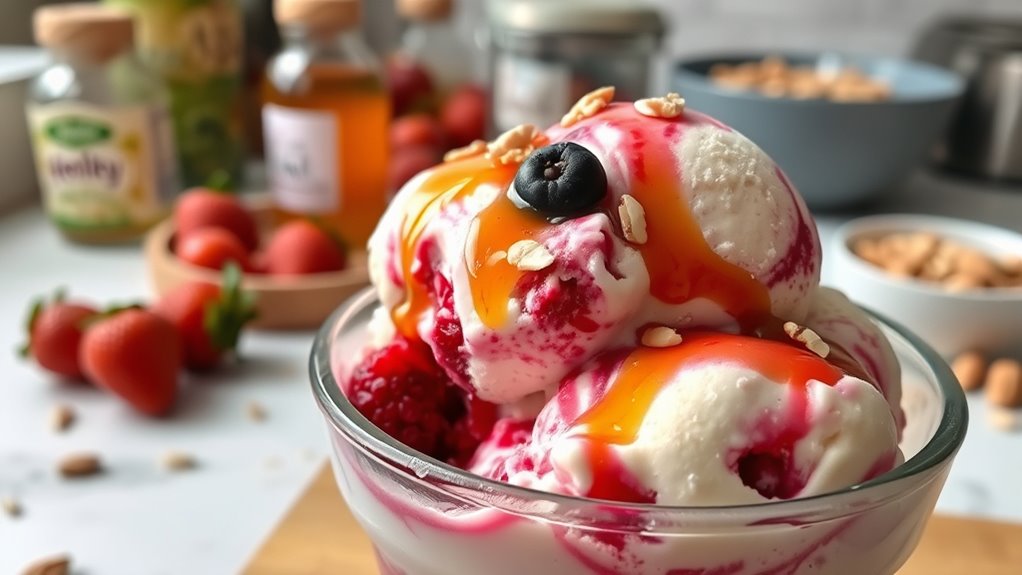
Making homemade ice cream isn’t just budget-friendly; it also offers a healthier alternative to store-bought options. When you make your own, you control the ingredients, allowing you to cater to dietary restrictions and avoid artificial additives. You can choose dairy alternatives like almond milk, coconut milk, or cashew cream, making it suitable for those who are lactose intolerant or vegan. This way, you reduce saturated fats and added sugars often found in commercial ice creams. Plus, customizing flavors and ingredients helps you create a nutritious treat aligned with your health goals. Additionally, color accuracy plays a role in ensuring that your homemade ice cream looks as appealing as it tastes, making the experience even more enjoyable. Homemade ice cream empowers you to enjoy a delicious dessert without sacrificing your dietary needs, making it a smarter, healthier choice compared to store-bought options.
Freshness and Texture Advantages
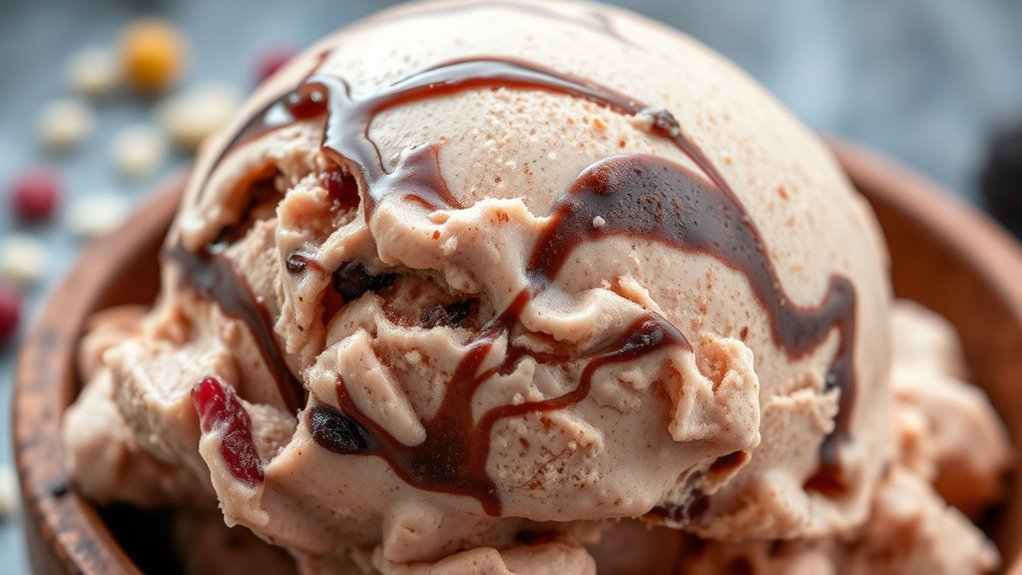
When you make ice cream at home, you retain much more freshness, so your treat stays vibrant and flavorful longer. You’ll also notice a creamier, smoother texture that’s hard to match with store-bought options. Plus, you control the ingredients, allowing you to choose higher-quality components for an even better experience. Using self-watering techniques can help maintain the ideal environment for your homemade ice cream, ensuring it stays at its best.
Superior Freshness Retention
Homemade ice cream often retains its freshness and creamy texture better than store-bought versions because you control the ingredients and freezing process. This means you can enhance storage techniques to preserve flavor and prevent freezer burn, extending shelf life. By sealing it tightly and avoiding temperature fluctuations, you keep the ice cream fresher longer. Unlike commercial options, homemade batches are free from preservatives that can degrade quality over time. Proper storage techniques ensure that your ice cream maintains ideal texture and flavor for more days. Additionally, making smaller batches reduces exposure to air and freezer burn, further improving freshness. Paying close attention to food preservation techniques can make a significant difference in quality. With careful attention to these factors, you enjoy a superior, fresher dessert whenever you crave it. Key points include:
- Airtight containers
- Consistent freezing temperatures
- Smaller batch sizes
- Avoiding temperature fluctuations
- Proper sealing techniques
Creamier, Smoother Texture
Because you control the ingredients and freezing process, homemade ice cream often boasts a creamier, smoother texture than store-bought versions. This is due to improved ice cream stability, which prevents ice crystal formation that can cause a gritty feel. When you make ice cream at home, you can adjust the churning time and temperature to guarantee ideal consistency, resulting in a velvety mouthfeel. Additionally, homemade batches tend to have better flavor consistency since you use fresh, quality ingredients without stabilizers or emulsifiers. This means each scoop maintains a uniform texture and richness, avoiding the ice crystallization common in commercial varieties. Furthermore, controlling the freezing process allows for better management of crystal growth, leading to a more luxurious, melt-in-your-mouth experience that store-bought versions often can’t match.
Customizable Ingredient Quality
By choosing your ingredients, you can prioritize freshness and quality, which directly enhances the texture of your ice cream. When you control ingredient sourcing, you select the best dairy options—like local, organic milk or cream—that contribute to richer, creamier textures. Fresh ingredients also preserve natural flavors, resulting in a more vibrant, authentic taste. You can avoid preservatives and artificial additives commonly found in store-bought ice creams, ensuring a healthier treat.
- Use fresh dairy options for a smoother, more satisfying mouthfeel
- Source ingredients locally for peak freshness
- Avoid long shelf lives that compromise texture
- Select high-quality fruits, nuts, and flavorings
- Adjust ingredient ratios for perfect creaminess
Creative Freedom in Recipes
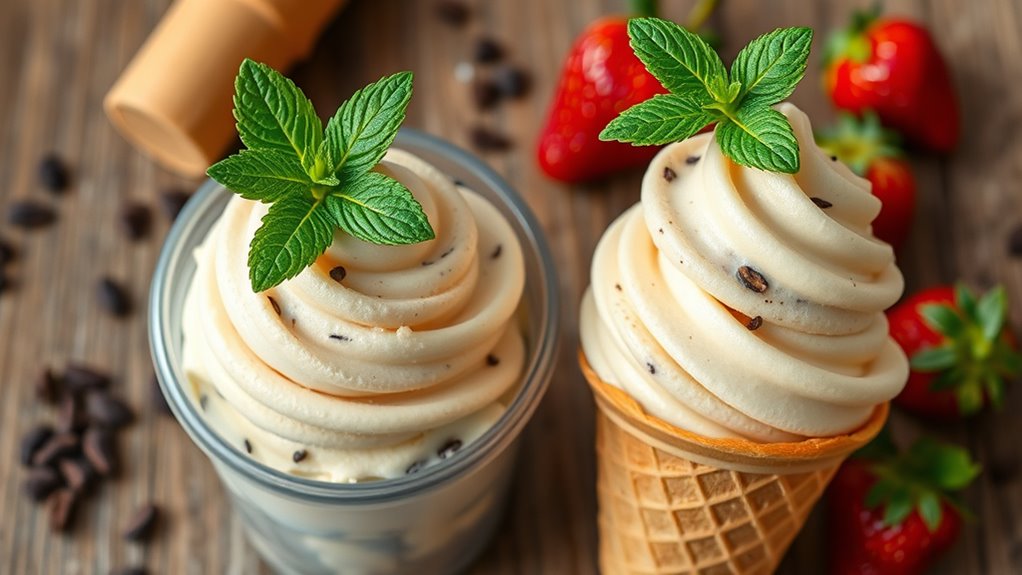
Creative freedom allows you to experiment with flavors, textures, and ingredients to craft ice cream that reflects your personal taste. With homemade recipes, you can explore gelato innovation by trying unique flavor combinations or adjusting creaminess to suit your preference. You’re not limited to traditional dairy; dairy alternatives like coconut milk, almond milk, or cashew cream let you create vegan or allergen-friendly options. Want a spicy chili chocolate or a tangy citrus sorbet? Go for it. Adjust sweetness, add mix-ins, or incorporate herbs and spices to make each batch truly yours. This flexibility empowers you to push boundaries, giving you the chance to develop signature recipes that store-bought brands simply can’t match. Your kitchen becomes a lab for endless ice cream possibilities, especially when you incorporate creative kitchen tools like specialized molds or mixing accessories.
Environmental Impact and Sustainability

As you experiment with flavor combinations and ingredients in your homemade ice cream, it’s worth considering how your choices impact the environment. Making ice cream at home often reduces packaging waste since you use reusable containers instead of single-use cartons or plastic wraps. Plus, you control ingredient sourcing, which can lower your carbon footprint by choosing locally produced items.
To further minimize environmental impact:
- Opt for organic and local ingredients
- Use reusable ice cream containers
- Avoid excessive packaging from store-bought products
- Reduce energy consumption with efficient appliances
- Limit waste by repurposing or composting leftovers
The Joy of Making Ice Cream at Home
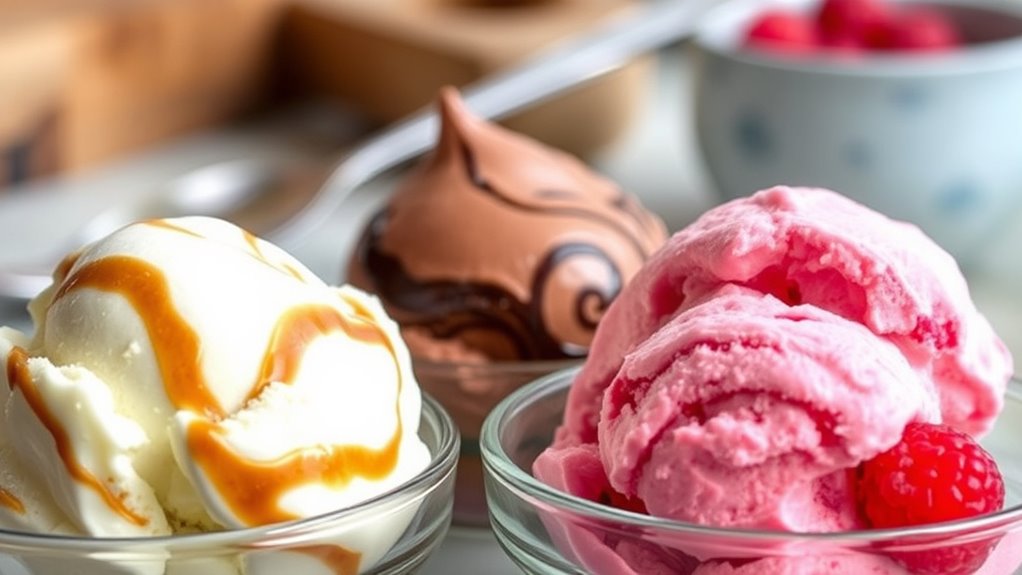
Have you ever experienced the pure joy of making your own ice cream? It’s a rewarding process that lets you embrace artisan techniques, giving each batch a personal touch. You control every ingredient, ensuring freshness and quality, which brings a sense of pride. The best part? flavor experimentation. You can mix in your favorite fruits, chocolates, or even spices, creating unique combinations that store-bought ice cream can’t match. Making ice cream at home isn’t just about the end product; it’s about the experience—learning new skills, customizing flavors, and enjoying the process. This hands-on approach transforms ice cream from a simple treat into a creative, satisfying activity. The joy comes from crafting something delicious, knowing you’ve made it yourself with care and imagination.
How to Get Started With Homemade Ice Cream
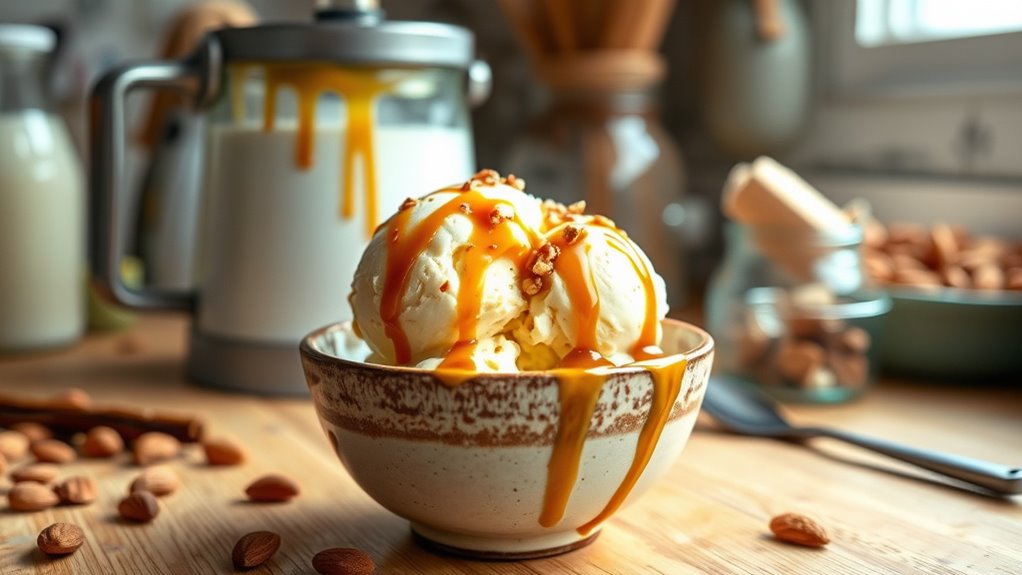
Getting started with homemade ice cream is simpler than you might think. First, choose your favorite ice cream flavors or experiment with new combinations. Next, gather basic ingredients like cream, milk, sugar, and flavorings. Investing in a good ice cream maker makes the process easier and yields smoother results. Don’t forget to plan ahead for storage—use airtight containers and leave some space for expansion. Additionally, exploring top beach towns on the East Coast can inspire your summer treats with fresh local ingredients and seaside flavors.
Here are some tips to get going:
- Start with simple recipes to build confidence
- Use high-quality ingredients for richer flavors
- Chill your mixture thoroughly before churning
- Mix in add-ins like fruit or nuts after churning
- Follow storage tips to keep your ice cream fresh and creamy
Frequently Asked Questions
What Are the Best Tools and Equipment for Homemade Ice Cream?
When making homemade ice cream, you’ll want essential tools like a good ice cream maker to guarantee smooth textures. Use mixing bowls for blending your favorite ice cream flavors and a whisk or spoon for mixing techniques. A thermometer helps monitor temperature, and spatulas assist in scraping and mixing. With these tools, you can experiment with endless flavors and perfect your mixing techniques for delicious, personalized ice cream every time.
How Long Does Homemade Ice Cream Typically Last in the Freezer?
You might wonder about the storage duration and freezer life of homemade ice cream. Typically, it lasts about 2 to 4 weeks in your freezer if stored properly in an airtight container. To maintain its best flavor and texture, avoid frequent thawing and refreezing. While it may last a bit longer, for ideal quality, enjoy your homemade treat within this timeframe.
Can I Make Dairy-Free or Vegan Ice Cream at Home?
Absolutely, you can make dairy-free or vegan ice cream at home. You just need to swap dairy ingredients with dairy free alternatives like coconut milk, almond milk, or cashew cream. Use vegan ingredient swaps such as agave syrup or maple syrup for sweetness and avoid dairy-based thickeners. With these simple changes, you can create delicious, creamy vegan ice cream tailored to your taste, all made fresh in your kitchen.
What Are Common Mistakes to Avoid When Making Ice Cream?
Making ice cream is like walking a tightrope—you need balance. To avoid common mistakes, don’t overmix the mixture, as it can cause ice crystals and a grainy texture. Also, neglecting temperature control during freezing can ruin your batch. Keep your ingredients cold and monitor the freezer’s temperature. These tips help you create smooth, creamy ice cream, avoiding pitfalls that turn a fun project into a frosty flop.
How Can I Store and Transport Homemade Ice Cream Safely?
To store and transport your homemade ice cream safely, choose proper containers like airtight, leak-proof ones to prevent freezer burn and spills. Keep the temperature consistent by maintaining your freezer at or below 0°F (-18°C). When transporting, use insulated bags or coolers with ice packs to control temperature and prevent melting. These steps help preserve flavor and texture, ensuring your homemade ice cream stays fresh and delicious wherever you go.
Conclusion
So, next time you crave a cool treat, consider making your own ice cream. You’ll enjoy fresh flavors, control ingredients, and even save some ducats in the long run. Plus, it’s a delightful way to channel your inner chef and embrace sustainability—think of it as a modern twist on an age-old tradition. Trust me, once you’ve experienced homemade ice cream, store-bought just won’t do. It’s a true culinary renaissance!
